Ancient Egypt › Ancient Egyptian Architecture » Ancient origins
Articles and Definitions › Contents
- Ancient Egypt › Antique Origins
- Ancient Egyptian Architecture › Ancient History
Ancient civilizations › Historical and archaeological sites
Ancient Egypt › Antique Origins
Definition and Origins
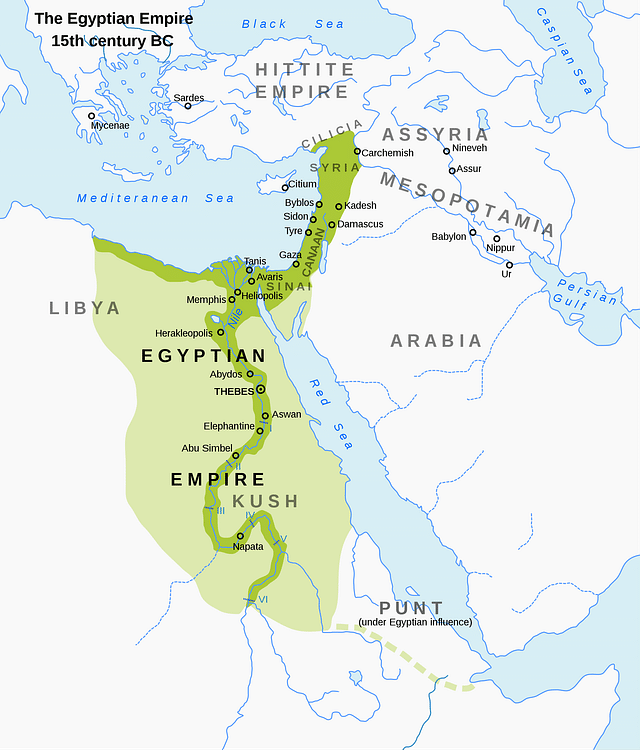
Egypt is a country in North Africa, on the Mediterranean Sea, and is home to one of the oldest civilizations on earth. The name 'Egypt' comes from the Greek Aegyptos which was the Greek pronunciation of the ancient Egyptian name 'Hwt-Ka-Ptah' ("Mansion of the Spirit of Ptah"), originally the name of the city of Memphis. Memphis was the first capital of Egypt and a famous religious and trade centre; its high status is attested to by the Greeks alluding to the entire country by that name.
To the ancient Egyptians themselves, their country was simply known as Kemet which means 'Black Land' so named for the rich, dark soil along the Nile River where the first settlements began. Later, the country was known as Misr which means 'country', a name still in use by Egyptians for their nation in the present day. Egypt thrived for thousands of years (from c. 8000 BCE to c. 30 BCE) as an independent nation whose culture was famous for great cultural advances in every area of human knowledge, from the arts to science to technology and religion. The great monuments which ancient Egypt is still celebrated for reflect the depth and grandeur of Egyptian culture which influenced so many ancient civilizations, among them Greeceand Rome.
One of the reasons for the enduring popularity of Egyptian culture is its emphasis on the grandeur of the human experience.Their great monuments, tombs, temples, and art work all celebrate life and stand as reminders of what once was and what human beings, at their best, are capable of achieving. Although ancient Egypt in popular culture is often associated with death and mortuary rites, something even in these speaks to people across the ages of what it means to be a human being and the power and purpose of remembrance.
To the Egyptians, life on earth was only one aspect of an eternal journey. The soul was immortal and was only inhabiting a body on this physical plane for a short time. At death, one would meet with judgment in the Hall of Truth and, if justified, would move on to an eternal paradise known as The Field of Reeds which was a mirror image of one's life on earth. Once one had reached paradise one could live peacefully in the company of those one had loved while on earth, including one's pets, in the same neighborhood by the same steam, beneath the very same trees one thought had been lost at death. This eternal life, however, was only available to those who had lived well and in accordance with the will of the gods in the most perfect place conducive to such a goal: the land of Egypt.
Egypt has a long history which goes back far beyond the written word, the stories of the gods, or the monuments which have made the culture famous. Evidence of overgrazing of cattle, on the land which is now the Sahara Desert, has been dated to about 8000 BCE. This evidence, along with artifacts discovered, points to a thriving agricultural civilization in the region at that time. As the land was mostly arid even then, hunter-gathering nomads sought the cool of the water source of the Nile River Valley and began to settle there sometime prior to 6000 BCE.
Organized farming began in the region c. 6000 BCE and communities known as the Badarian Culture began to flourish alongside the river. Industry developed at about this same time as evidenced by faience workshops discovered at Abydos dating to c. 5500 BCE. The Badarian were followed by the Amratian, the Gerzean, and the Naqada cultures (also known as Naqada I, Naqada II, and Naqada III), all of which contributed significantly to the development of what became Egyptian civilization. The written history of the land begins at some point between 3400 and 3200 BCE when hieroglyphic script is developed by the Naqada Culture III. By 3500 BCE mummification of the dead was in practice at the city of Hierakonpolis and large stone tombs built at Abydos. The city of Xois is recorded as being already ancient by 3100-2181 BCE as inscribed on the famous Palermo Stone. As in other cultures world-wide, the small agrarian communities became centralized and grew into larger urban centers.
PROSPERITY LED TO, AMONG OTHER THINGS, AN INCREASE IN THE BREWING OF BEER, MORE LEISURE TIME FOR SPORTS, AND ADVANCES IN MEDICINE.
EARLY HISTORY OF EGYPT
The Early Dynastic Period (c. 3150-c. 2613 BCE) saw the unification of the north and south kingdoms of Egypt under the king Menes ( also known as Meni or Manes) of Upper Egypt who conquered Lower Egypt in c. 3118 BCE or c. 3150 BCE. This version of the early history comes from the Aegyptica (History of Egypt) by the ancient historian Manetho who lived in the 3rd century BCE under the Ptolemaic Dynasty (323-30 BCE). Although his chronology has been disputed by later historians, it is still regularly consulted on dynastic succession and the early history of ancient Egypt.
Manetho's work is the only source which cites Menes and the conquest and it is now thought that the man referred to by Manetho as `Menes' was the king Narmer who peacefully united Upper and Lower Egypt under one rule. Identification of Menes with Narmer is far from universally accepted, however, and Menes has been as credibly linked to the king Hor-Aha (c. 3100-3050 BCE)who succeeded him. An explanation for Menes' association with his predecessor and successor is that `Menes' is an honorific title meaning "he who endures" and not a personal name and so could have been used to refer to more than one king. The claim that the land was unified by military campaign is also disputed as the famous Narmer Palette, depicting a military victory, is considered by some scholars to be royal propaganda. The country may have first been united peacefully but this seems unlikely.
Geographical designation in ancient Egypt follows the direction of the Nile River and so Upper Egypt is the southern region and Lower Egypt the northern area closer to the Mediterranean Sea. Narmer ruled from the city of Heirakonopolis and then from Memphis and Abydos. Trade increased significantly under the rulers of the Early Dynastic Period and elaborate mastaba tombs, precursors to the later pyramids, developed in ritual burial practices which included increasingly elaborate mummification techniques.
THE GODS
From the Pre-Dynastic Period (c. 6000-c.3150 BCE) a belief in the gods defined the Egyptian culture. An early Egyptian creation myth tells of the god Atum who stood in the midst of swirling chaos before the beginning of time and spoke creation into existence. Atum was accompanied by the eternal force of heka (magic), personified in the god Heka and by other spiritual forces which would animate the world. Heka was the primal force which infused the universe and caused all things to operate as they did; it also allowed for the central value of the Egyptian culture: ma'at, harmony and balance.
All of the gods and all of their responsibilties went back to ma'at and heka. The sun rose and set as it did and the moon traveled its course across the sky and the seasons came and went in accordance with balance and order which was possible because of these two agencies. Ma'at was also personified as a deity, the goddess of the ostrich feather, to whom every king promised his full abilities and devotion. The king was associated with the god Horus in life and Osiris in death based upon a myth which became the most popular in Egyptian history.
Osiris and his sister-wife Isis were the original monarchs who governed the world and gave the people the gifts of civilization.Osiris' brother, Set, grew jealous of him and murdered him but he was brought back to life by Isis who then bore his son Horus.Osiris was incomplete, however, and so descended to rule the underworld while Horus, once he had matured, avenged his father and defeated Set. This myth illustrated how order triumphed over chaos and would become a persistent motif in mortuary rituals and religious texts and art. There was no period in which the gods did not play an integral role in the daily lives of the Egyptians and this is clearly seen from the earliest times in the country's history.

The Pyramids
THE OLD KINGDOM
During the period known as the Old Kingdom (c. 2613-2181 BCE), architecture honoring the gods developed at an increased rate and some of the most famous monuments in Egypt, such as the pyramids and the Great Sphinx at Giza, were constructed. The king Djoser, who reigned c. 2670 BCE, built the first Step Pyramid at Saqqara c. 2670, designed by his chief architect and physician Imhotep (c. 2667-2600 BCE) who also wrote one of the first medical texts describing the treatment of over 200 different diseases and arguing that the cause of disease could be natural, not the will of the gods. The Great Pyramid of Khufu (last of the seven wonders of the ancient world) was constructed during his reign (2589-2566 BCE) with the pyramids of Khafre (2558-2532 BCE) and Menkaure (2532-2503 BCE) following.
The grandeur of the pyramids on the Giza plateau, as they originally would have appeared, sheathed in gleaming white limestone, is a testament to the power and wealth of the rulers during this period. Many theories abound regarding how these monuments and tombs were constructed but modern architects and scholars are far from agreement on any single one.Considering the technology of the day, some have argued, a monument such as the Great Pyramid of Giza should not exist.Others claim, however, that the existence of such buildings and tombs suggest superior technology which has been lost to time.
There is absolutely no evidence that the monuments of the Giza plateau - or any others in Egypt - were built by slave labor nor is there any evidence to support a historical reading of the biblical Book of Exodus. Most reputable scholars today reject the claim that the pyramids and other monuments were built by slave labor although slaves of different nationalities certainly did exist in Egypt and were employed regularly in the mines. Egyptian monuments were considered public works created for the state and used both skilled and unskilled Egyptian workers in construction, all of whom were paid for their labor. Workers at the Giza site, which was only one of many, were given a ration of beer three times a day and their housing, tools, and even their level of health care have all been clearly established.
THE FIRST INTERMEDIATE PERIOD & THE HYKSOS
The era known as The First Intermediate Period (2181-2040 BCE) saw a decline in the power of the central government following its collapse. Largely independent districts with their own governors developed throughout Egypt until two great centers emerged: Hierakonpolis in Lower Egypt and Thebes in Upper Egypt. These centers founded their own dynasties which ruled their regions independently and intermittently fought with each other for supreme control until c. 2040 BCE when the Theban king Mentuhotep II (c. 2061-2010 BCE) defeated the forces of Hierakonpolis and united Egypt under the rule of Thebes.
The stability provided by Theban rule allowed for the flourishing of what is known as the Middle Kingdom (2040-1782 BCE).The Middle Kingdom is considered Egypt's `Classical Age' when art and culture reached great heights and Thebes became the most important and wealthiest city in the country. According to the historians Oakes and Gahlin, “the Twelfth Dynasty kings were strong rulers who established control not only over the whole of Egypt but also over Nubia to the south, where several fortresses were built to protect Egyptian trading interests” (11). The first standing army was created during the Middle Kingdom by the king Amenemhat I (c. 1991-1962 BCE) the temple of Karnak was begun under Senruset I (c. 1971-1926 BCE), and some of the greatest art and literature of the civilization was produced. The 13th Dynasty, however, was weaker than the 12th and distracted by internal problems which allowed for a foriegn people known as the Hyksos to gain power in Lower Egypt around the Nile Delta.
The Hyksos are a mysterious people, most likely from the area of Syria / Palestine, who first appeared in Egypt c. 1800 and settled in the town of Avaris. While the names of the Hyksos kings are Semitic in origin, no definite ethnicity has been established for them. The Hyksos grew in power until they were able to take control of a significant portion of Lower Egypt by c. 1720 BCE, rendering the Theban Dynasty of Upper Egypt almsot a vassal state.
This era is known as The Second Intermediate Period (c.1782-c.1570 BCE). While the Hyksos (whose name simply means `foreign rulers') were hated by the Egyptians, they introduced a great many improvements to the culture such as the composite bow, the horse, and the chariot along with crop rotation and developments in bronze and ceramic works. At the same time the Hyksos controlled the ports of Lower Egypt, by 1700 BCE the Kingdom of Kush had risen to the south of Thebes in Nubia and now held that border. The Egyptians mounted a number of campaigns to drive the Hyksos out and subdue the Nubians but all failed until prince Ahmose I of Thebes (c.1570-1544 BCE) succeeded and unified the country under Theban rule.
THE NEW KINGDOM & THE AMARNA PERIOD
Ahmose I initiated what is known as the period of the New Kingdom (c.1570- c.1069 BCE) which again saw great prosperity in the land under a strong central government. The title of pharaoh for the ruler of Egypt comes from the period of the New Kingdom; earlier monarchs were simply known as kings. Many of the Egyptian sovereigns best known today ruled during this period and the majority of the great structures of antiquity such as the Ramesseum, Abu Simbel, the temples of Karnak and Luxor, and the tombs of the Valley of the Kings and Valley of the Queens were either created or greatly enhanced during this time.
Between 1504-1492 BCE the pharaoh Tuthmosis I consolidated his power and expanded the boundaries of Egypt to the Euphrates River in the north, Syria and Palestine to the west, and Nubia to the south. His reign was followed by Queen Hatshepsut (1479-1458 BCE) who greatly expanded trade with other nations, most notably the Land of Punt. Her 22-year reign was one of peace and prosperity for Egypt.
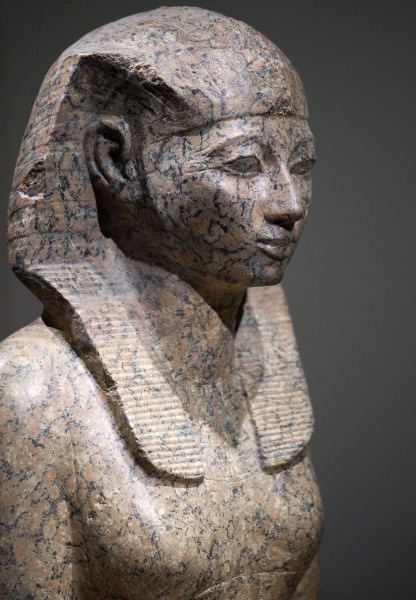
Portrait of Queen Hatshepsut
Her successor, Tuthmosis III, carried on her policies (although he tried to eradicate all memory of her as, it is thought, he did not want her to serve as a role model for other women since only males were considered worthy to rule) and, by the time of his death in 1425 BCE, Egypt was a great and powerful nation. The prosperity led to, among other things, an increase in the brewing of beer in many different varieties and more leisure time for sports. Advances in medicine led to improvements in health.
Bathing had long been an important part of the daily Egyptian's regimen as it was encouraged by their religion and modeled by their clergy. At this time, however, more elaborate baths were produced, presumably more for leisure than simply hygiene. The Kahun Gynecological Papyrus, concerning women's health and contraceptives, had been written c. 1800 BCE and, during this period, seems to have been made extensive use of by doctors. Surgery and dentistry were both practiced widely and with great skill, and beer was prescribed by physicians for ease of symptoms of over 200 different maladies.
In 1353 BCE the pharaoh Amenhotep IV succeeded to the throne and, shortly after, changed his name to Akhenaten (`living spirit of Aten') to reflect his belief in a single god, Aten. The Egyptians, as noted above, traditionally believed in many gods whose importance influenced every aspect of their daily lives. Among the most popular of these deities were Amun, Osiris, Isis, and Hathor. The cult of Amun, at this time, had grown so wealthy that the priests were almost as powerful as the pharaoh. Akhenaten and his queen, Nefertiti, renounced the traditional religious beliefs and customs of Egypt and instituted a new religion based upon the recognition of one god.
His religious reforms effectively cut the power of the priests of Amun and placed it in his hands. He moved the capital from Thebes to Amarna to further distance his rule from that of his predecessors. This is known as The Amarna Period (1353-1336 BCE) during which Amarna grew as the capital of the country and polytheistic religious customs were banned.
Among his many accomplishments, Akhenaten was the first ruler to decree statuary and a temple in honor of his queen instead of only for himself or the gods and used the money which once went to the temples for public works and parks. The power of the clergy declined sharply as that of the central government grew, which seemed to be Akhenaten's goal, but he failed to use his power for the best interest of his people. The Amarna Letters make clear that he was more concerned with his religious reforms than with foreign policy or the needs of the people of Egypt.

Death Mask of Tutankhamun
His reign was followed by his son, the most recognizable Egyptian ruler in the modern day, Tutankhamun, who reigned from c.1336- c.1327 BCE. He was originally named `Tutankhaten' to reflect the religious beliefs of his father but, upon assuming the throne, changed his name to `Tutankhamun' to honor the ancient god Amun. He restored the ancient temples, removed all references to his father's single deity, and returned the capital to Thebes. His reign was cut short by his death and, today, he is most famous for the intact grandeur of his tomb, discovered in 1922 CE, which became an international sensation at the time.
The greatest ruler of the New Kingdom, however, was Ramesses II (also known as Ramesses the Great, 1279-1213 BCE) who commenced the most elaborate building projects of any Egyptian ruler and who reigned so efficiently that he had the means to do so. Although the famous Battle of Kadesh of 1274 (between Ramesses II of Egypt and Muwatalli II of the Hitties) is today regarded as a draw, Ramesses considered it a great Egyptian victory and celebrated himself as a champion of the people, and finally as a god, in his many public works.
His temple of Abu Simbel (built for his queen Nefertari) depicts the battle of Kadesh and the smaller temple at the site, following Akhenaten's example, is dedicated to Ramesses favorite queen Nefertari. Under the reign of Ramesses II the first peace treaty in the world (The Treaty of Kadesh) was signed in 1258 BCE and Egypt enjoyed almost unprecedented affluence as evidenced by the number of monuments built or restored during his reign.
Ramesses II's fourth son, Khaemweset (c.1281-c.1225 BCE), is known as the "First Egyptologist" for his efforts in preserving and recording old monuments, temples, and their original owner's names. It is largely due to Khaemweset's initiative that Ramesses II's name is so prominent at so many ancient sites in Egypt. Khaemweset left a record of his own efforts, the original builder/owner of the monument or temple, and his father's name as well.
Ramesses II became known to later generations as `The Great Ancestor' and reigned for so long that he out-lived most of his children and his wives. In time, all of his subjects had been born knowing only Ramesses II as their ruler and had no memory of another. He enjoyed an exceptionally long life of 96 years, over double the average life-span of an ancient Egyptian. Upon his death, it is recorded that many feared the end of the world had come as they had known no other pharaoh and no other kind of Egypt.
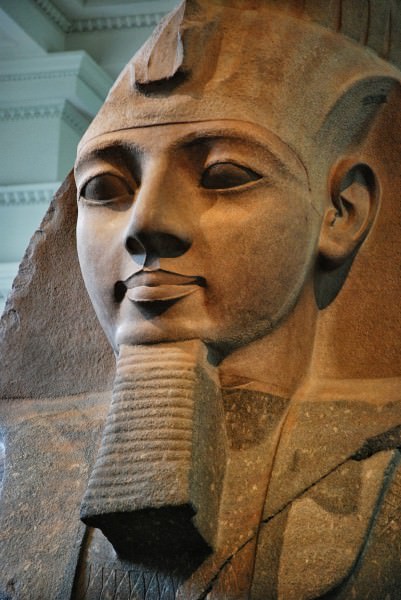
Ramesses II Statue
THE DECLINE OF EGYPT & THE COMING OF ALEXANDER THE GREAT
One of his successors, Ramesses III (1186-1155 BCE), followed his policies but, by this time, Egypt's great wealth had attracted the attention of the Sea Peoples who began to make regular incursions along the coast. The Sea Peoples, like the Hyksos, are of unknown origin but are thought to have come from the southern Aegean area. Between 1276-1178 BCE the Sea Peoples were a threat to Egyptian security. Ramesses II had defeated them in a naval battle early in his reign as had his successor Merenptah (1213-1203 BCE). After Merenptah's death, however, they increased their efforts, sacking Kadesh, which was then under Egyptian control, and ravaging the coast. Between 1180-1178 BCE Ramesses III fought them off, finally defeating them at the Battle of Xois in 1178 BCE.
Following the reign of Ramesses III, his successors attempted to maintain his policies but increasingly met with resistance from the people of Egypt, those in the conquered territories, and, especially, the priestly class. In the years after Tutankhamun had restored the old religion of Amun, and especially during the great time of prosperity under Ramesses II, the priests of Amun had acquired large tracts of land and amassed great wealth which now threatened the central government and disrupted the unity of Egypt. By the time of Ramesses XI (1107-1077 BCE), the end of the 20th Dynasty, the government had become so weakened by the power and corruption of the clergy that the country again fractured and central administration collapsed, initiating the so-called Third Intermediate Period of c.1069-525 BCE.
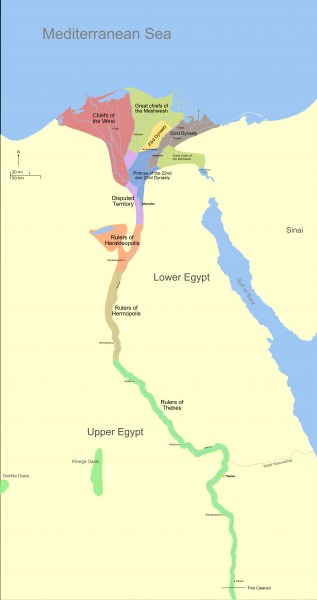
Map of the Third Intermediate Period
Under the Kushite King Piye (752-722 BCE), Egypt was again unified and the culture flourished, but beginning in 671 BCE, the Assyrians under Esarhaddon began their invasion of Egypt, conquering it by 666 BCE under his successor Ashurbanipal.Having made no long-term plans for control of the country, the Assyrians left it in ruin in the hands of local rulers and abandoned Egypt to its fate. Egypt rebuilt and re-fortified, however, and this is the state the country was in when Cambyses IIof Persia struck at the city of Pelusium in 525 BCE. Knowing the reverence the Egyptians held for cats (who were thought living representations of the popular goddess Bastet ) Cambyses II ordered his men to paint cats on their shields and to drive cats, and other animals sacred to the Egyptians, in front of the army toward Pelusium. The Egyptian forces surrendered and the country fell to the Persians. It would remain under Persian occupation until the coming of Alexander the Great in 332 BCE.
Alexander was welcomed as a liberator and conquered Egypt without a fight. He established the city of Alexandria and moved on to conquer Phoenicia and the rest of the Persian Empire. After his death in 323 BCE his general, Ptolemy, brought his body back to Alexandria and founded the Ptolemaic Dynasty (323-30 BCE). The last of the Ptolemies was Cleopatra VII who committed suicide in 30 BCE after the defeat of her forces (and those of her consort Mark Antony ) by the Romans under Octavian Caesar at the Battle of Actium (31 BCE). Egypt then became a province of Rome (30 BCE-476 CE) then of the Byzantine Empire (c. 527-646 CE) until it was conquered by the Arab Muslims under Caliph Umar in 646 CE and fell under Islamic Rule. The glory of Egypt's past, however, was re-discovered during the 18th and 19th centuries CE and has had a profound impact on the present day's understanding of ancient history and the world. Historian Will Durant expresses a sentiment felt by many:
The effect or remembrance of what Egypt accomplished at the very dawn of history has influence in every nation and every age. 'It is even possible', as Faure has said, 'that Egypt, through the solidarity, the unity, and the disciplined variety of its artistic products, through the enormous duration and the sustained power of its effort, offers the spectacle of the greatest civilization that has yet appeared on the earth.' We shall do well to equal it.(217)
Egyptian Culture and history has long held a universal fascination for people; whether through the work of early archeologists in the 19th century CE (such as Champollion who deciphered the Rosetta Stone in 1822 CE) or the famous discovery of the Tomb of Tutankhamun by Howard Carter in 1922 CE. The ancient Egyptian belief in life as an eternal journey, created and maintained by divine magic, inspired later cultures and later religious beliefs. Much of the iconography and the beliefs of Egyptian religion found their way into the new religion of Christianity and many of their symbols are recognizable today with largely the same meaning. It is an important testimony to the power of the Egyptian civilization that so many works of the imagination, from films to books to paintings even to religious belief, have been and continue to be inspired by its elevating and profound vision of the universe and humanity's place in it.
MAP
Ancient Egyptian Architecture › Ancient History
Definition and Origins

The pyramids are the most recognizable symbol of ancient Egypt. Even though other civilizations, such as the Maya or the Chinese, also employed this form, the pyramid in the modern day is synonymous in most people's minds with Egypt. The pyramids at Giza remain impressive monuments thousands of years after they were built and the knowledge and skill required to construct them was gathered over the many centuries prior to their construction. Yet the pyramids are not the apex of ancient Egyptian architecture ; they are only the earliest and best known expressions of a culture which would go on to create buildings, monuments, and temples just as intriguing.
6,000 YEARS OF HISTORY
Ancient Egyptian history begins prior to the Pre-Dynastic Period (c. 6000 - 3150 BCE) and continues through the end of the Ptolemaic Dynasty (323 - 30 BCE). Artifacts and evidence of overgrazing of cattle, in the area now known as the Sahara Desert, date human habitation in the area to c. 8000 BCE. The Early Dynastic Period (c. 3150 - 2613 BCE) built upon the knowledge of those who had gone before and Pre-Dynastic art and architecture was improved on. The first pyramid in Egypt, Djoser 's Step Pyramid at Saqqara, comes from the end of this Early Dynastic Period and a comparison of this monument and its surrounding complex with the mastaba tombs of earlier centuries show how far the Egyptians had advanced in their understanding of architectural design and construction. Equally impressive, however, is the link between these great monuments and those which came after them.
The pyramids at Giza date from the Old Kingdom (c. 2613 - 2181 BCE) and represent the pinnacle of talent and skill acquired at that time. Ancient Egyptian history, however, still had a long and illustrious path before it and as the pyramid form was abandoned the Egyptians focused their attention on temples. Many of these whose ruins are still extant, such as the templecomplex of Amun -Ra at Karnak, inspire as much genuine awe as the pyramids of Giza but all of them, however great or modest, show an attention to detail and an awareness of aesthetic beauty and practical functionality which makes them masterpieces of architecture. These structures still resonate in the present day because they were conceived, designed, and raised to tell an eternal story which they still relate to everyone who visits the sites.
EGYPTIAN STRUCTURES STILL RESONATE IN THE PRESENT DAY BECAUSE THEY WERE CONCEIVED, DESIGNED, & RAISED TO TELL AN ETERNAL STORY WHICH THEY STILL RELATE TO EVERYONE WHO VISITS THE SITES.
EGYPTIAN ARCHITECTURE & THE CREATION OF THE WORLD
At the beginning of time, according to Egyptian belief, there was nothing but swirling waters of dark chaos. From these primordial waters rose a mound of dry land, known as the ben-ben, around which the waters rolled. Upon the mound lighted the god Atum who looked out over the darkness and felt lonely; so he mated with himself and creation began.
Atum was responsible for the unknowable universe, the sky above, and the earth below. Through his children he was also the creator of human beings (though in some versions the goddess Neith plays a part in this). The world and all that human beings knew came from water, from dampness, moistness, from the kind of environment familiar to the Egyptians from the NileDelta. Everything had been created by the gods and these gods were ever-present in one's life through nature.
When the Nile River overflowed its banks and deposited the life-giving soil the people depended upon for their crops it was the work of the god Osiris. When the sun set in the evening it was the god Ra in his barge going down into the underworld and the people gladly participated in rituals to make sure he would survive attacks from his nemesis Apophis and rise again the next morning. The goddess Hathor was present in the trees, Bastet kept women's secrets and protected the home, Thothgave people the gift of literacy, Isis, although a great and powerful goddess, had also been a single mother who raised her young son Horus in the swamps of the Delta and watched over mothers on earth.
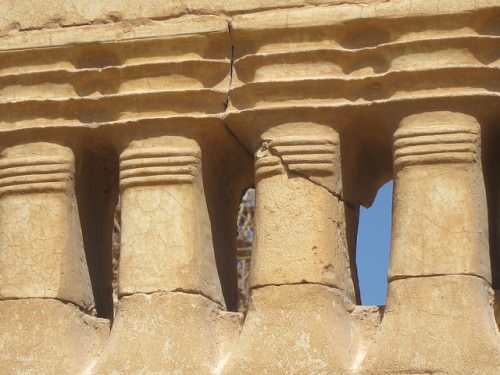
Djed pillars
The lives of the gods mirrored those of the people and the Egyptians honored them in their lives and through their works. The gods were thought to have provided the most perfect of worlds for the people of ancient Egypt; so perfect, in fact, that it would last forever. The afterlife was simply a continuation of the life one had been living. It is not surprising, then, that when these people constructed their great monuments they would reflect this belief system. The architecture of ancient Egypt tells this story of the people's relationship with their land and their gods. The symmetry of the structures, the inscriptions, the interior design, all reflect the concept of harmony (ma'at) which was central to the ancient Egyptian value system.
THE PRE-DYNASTIC & EARLY DYNASTIC PERIODS
In the Pre-Dynastic Period images of the gods and goddesses appear in sculpture and ceramics but the people did not yet have the technical skill to raise massive structures to honor their leaders or deities. Some form of government is evident during this period but it seems to have been regional and tribal, nothing like the central government which would appear in the Old Kingdom.
The homes and tombs of the Pre-Dynastic Period were built of mud brick which was dried in the sun (a practice which would continue throughout Egypt's history). Homes were thatched structures of reeds which were daubed with mud for walls prior to the discovery of brick making. These early buildings were circular or oval before bricks were used and, after, became square or rectangular. Communities gathered together for protection from the elements, wild animals, and strangers and grew into cities which encircled themselves with walls.
As civilization advanced, so did the architecture with the appearance of windows and doors braced and adorned by wooden frames. Wood was more plentiful in Egypt at this time but still not in the quantity to suggest itself as a building material on any large scale. The mud brick oval home became the rectangular house with a vaulted roof, a garden, and courtyard. Work in mud brick is also evidenced in the construction of tombs which, during the Early Dynastic Period, become more elaborate and intricate in design. These early oblong tombs (mastabas) continued to be built of mud brick but already at this time people were working in stone to create temples to their gods. Stone monuments (stelae) begin to appear in Egypt, along with these temples, by the 2nd Dynasty (c. 2890 - c. 2670 BCE).
Obelisks, large upright stone monuments with four sides and a tapered top, began to appear in the city of Heliopolis at about this time. The obelisk (known to the Egyptians as tekhenu, "obelisk" being the Greek name) is among the most perfect examples of Egyptian architecture reflecting the relationship between the gods and the people as they were always raised in pairs and it was thought that the two created on earth were mirrored by two identical pieces raised in the heavens at the same time. Quarrying, carving, transporting, and raising the obelisks required enormous skill and labor and taught the Egyptians well how to work in stone and move immensely heavy objects over many miles. Mastering stonework set the stage for the next great leap in Egyptian architecture: the pyramid.
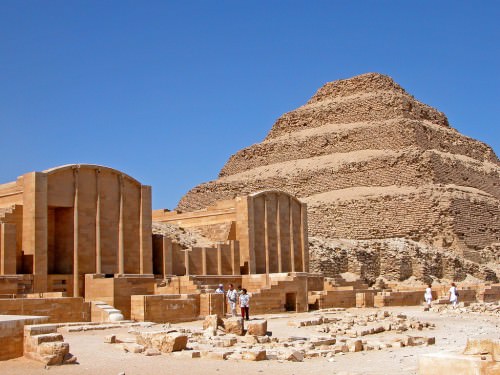
Step Pyramid Complex at Saqqara
Djoser's mortuary complex at Saqqara was conceived by his vizier and chief architect Imhotep (c. 2667 - c. 2600 BCE) who imagined a great mastaba tomb for his king built of stone. Djoser's pyramid is not a "true pyramid" but a series of stacked mastabas known as a "step pyramid". Even so, it was an incredibly impressive feat which had never been achieved before.Historian Desmond Stewart comments on this:
Djoser's Step Pyramid at Saqqara marks one of those developments that afterward seem inevitable but that would have been impossible without an experimenting genius. That the royal official Imhotep was such a genius we know, not from Greek legend, which identified him with Aesculapius, the god of medicine, but from what archaeologists have discovered from his still impressive pyramid. Investigation has shown that, at every stage, he was prepared to experiment along new lines. His first innovation was to construct a mastaba that was not oblong, but square. His second concerned the material from which it was built (cited in Nardo, 125).
Temple construction, albeit on a modest level, had already acquainted the Egyptians with stonework. Imhotep imagined the same on a grand scale. The early mastabas had been decorated with inscriptions and engravings of reeds, flowers, and other nature imagery; Imhotep wanted to continue that tradition in a more durable material. His great, towering mastaba pyramid would have the same delicate touches and symbolism as the more modest tombs which had preceded it and, better yet, these would all be worked in stone instead of dried mud. Historian Mark Van de Mieroop comments on this:
Imhotep reproduced in stone what had been previously built of other materials. The facade of the enclosure wallhad the same niches as the tombs of mud brick, the columns resembled bundles of reed and papyrus, and stone cylinders at the lintels of doorways represented rolled-up reed screens. Much experimentation was involved, which is especially clear in the construction of the pyramid in the center of the complex. It had several plans with mastaba forms before it became the first Step Pyramid in history, piling six mastaba-like levels on top of one another...The weight of the enormous mass was a challenge to the builders, who placed the stones at an inward incline in order to prevent the monument breaking up (56).
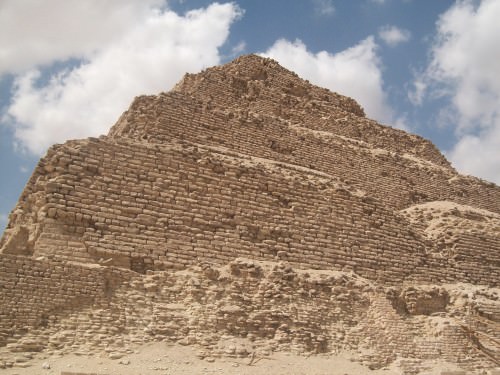
Detail, Step Pyramid of Djoser
When completed, the Step Pyramid rose 204 feet (62 meters) high and was the tallest structure of its time. The surrounding complex included a temple, courtyards, shrines, and living quarters for the priests covering an area of 40 acres (16 hectares) and surrounded by a wall 30 feet (10.5 meters) high. The wall had 13 false doors cut into it with only one true entrance cut in the south-east corner; the entire wall was then ringed by a trench 2,460 feet (750 meters) long and 131 feet (40 meters) wide.The actual tomb of Djoser was located beneath the pyramid at the bottom of a shaft 92 feet (28 meters) long. The tomb chamber itself was encased in granite but, to reach it, one had to traverse a maze of hallways, all brightly painted with reliefs and inlaid with tiles, leading to other rooms or dead ends filled with stone vessels carved with the names of earlier kings. This labyrinth was created, of course, to protect the tomb and grave goods of the king but, unfortunately, it failed to keep out ancient grave robbers and the tomb was looted at some point in antiquity.
Djoser's Step Pyramid incorporates all of the elements most resonant in Egyptian architecture: symmetry, balance, and grandeur which reflected the core values of the culture. Egyptian civilization was based upon the concept of ma'at (harmony, balance) which was decreed by their gods. The architecture of ancient Egypt, whether on a small or large scale, always represented these ideals. Palaces were even built with two entrances, two throne rooms, two recieving halls in order to maintain symmetry and balance in representing both Upper and Lower Egypt in the design
THE OLD KINGDOM & THE PYRAMIDS
The innovations of Imhotep were carried further by the kings of the 4th Dynasty in the Old Kingdom. The last king of the 3rd Dynasty, Huni (c. 2630 - 2613 BCE), was long thought to have initiated the massive building projects of the Old Kingdom in constructing the pyramid at Meidum but that honor is due the first king of the 4th Dynasty, Sneferu (c. 2613 - 2589 BCE).Egyptologist Barbara Watterson writes, "Sneferu initiated the golden age of the Old Kingdom, his most notable achievements being the two pyramids built for him at Dahshur" (50-51). Sneferu began his work with the pyramid at Meidum now referred to as the "collapsed pyramid" or, locally, as the "false pyramid" because of its shape: it resembles a tower more than a pyramid and its outer casing rests around it in a gigantic heap of gravel.
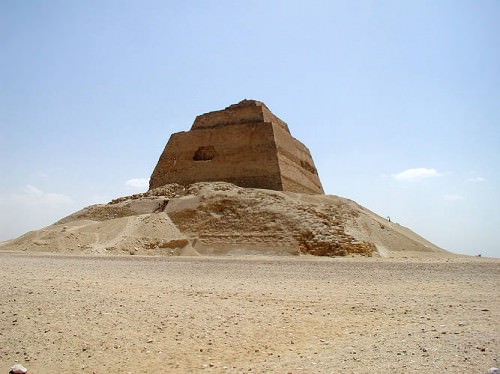
Meidum Pyramid
The pyramid of Meidum is the first true pyramid constructed in Egypt. A "true pyramid" is defined as a perfectly symmetrical monument whose steps have been filled in to create seamless sides tapering toward a point at the top. Originally, any pyramid began as a step pyramid. The Meidum pyramid did not last, however, because modifications were made to Imhotep's original pyramid design which resulted in the outer casing resting on a sand foundation rather than rock, causing it to collapse.Scholars are divided on whether the collapse occured during construction or over a longer period of time.
Sneferu's experiments with the stone pyramid form served his successor well. Khufu (2589 - 2566 BCE) learned from his father's experiments and directed his administration in constructing the Great Pyramid of Giza, the last of the original Seven Wonders of the Ancient World. Contrary to the popular belief that his monument was built by Hebrew slaves, Egyptian workers on the Great Pyramid were well cared for and performed their duties as part of a community service, as paid laborers, or during the time when the Nile's flood made farming impossible. Scholars Bob Brier and Hoyt Hobbs note:
Were it not for the two months every year when the Nile's water covered Egypt's farmland, idling virtually the entire workforce, none of this construction would have been possible. During such times, a pharaoh offered food for work and the promise of a favored treatment in the afterworld where he would rule just as he did in this world.For two months annually, workmen gathered by the tens of thousands from all over the country to transport the blocks a permanent crew had quarried during the rest of the year. Overseers organized the men into teams to transport the stones on sleds, devices better suited than wheeled vehicles to moving weighty objects over shifting sand. A causeway, lubricated by water, smoothed the uphill pull. No mortar was used to hold the blocks in place, only a fit so exact that these towering structures have survived for 4,000 years - the only Wonders of the Ancient World still standing today (17-18).
There is no evidence whatsoever that Hebrew slaves, or any kind of slave labor, went into the construction of the pyramids at Giza, the city of Per-Ramesses, or any other important site in Egypt. The practice of slavery certainly existed in Egypt throughout its history, as it did in every ancient culture, but it was not the kind of slavery popularly depicted in fiction and film based on the biblical Book of Exodus. Slaves in the ancient world could be tutors and teachers of the young, accountants, nursemaids, dance instructors, brewers, even philosophers. Slaves in Egypt were either captives from military campaigns or those who could not pay their debts and these people usually worked in the mines and quarries.

The Pyramids
The men and women who worked on the Great Pyramid lived in state-provided housing on the site (as discovered by Lehner and Hawass in 1979 CE) and were well compensated for their efforts. The more skilled a worker was, the higher their compensation. The result of their work still amazes people in the modern day. The Great Pyramid is the only wonder left of the ancient Seven Wonders of the World and justifiably so: until the Eifel Tower was completed in 1889 CE, the Great Pyramid was the tallest structure on earth built by human hands. Historian Marc van de Mieroop writes:
The size boggles the mind: it was 146 meters high (479 feet) by 230 meters at the base (754 feet). We estimate that it contained 2,300,000 blocks of stone with an average weight of 2 and 3/4 tons some weighing up to 16 tons. Khufu ruled 23 years according to the Turin Royal Canon, which would mean that throughout his reign annually 100,000 blocks - daily about 285 blocks or one every two minutes of daylight - had to be quarried, transported, dressed, and put in place...The construction was almost faultless in design. The sides were oriented exactly toward the cardinal points and were at precise 90-degree angles (58).
La segunda pirámide construida en Giza pertenece al sucesor de Keops, Kefre (2558 - 2532 aC), a quien también se le atribuye la creación de la Gran Esfinge. La tercera pirámide pertenece a su sucesor Menkaure (2532 - 2503 AEC). Una inscripción de c. 2520 aC relata cómo Menkaure vino a inspeccionar su pirámide y asignó a 50 de los trabajadores a la nueva tarea de construir una tumba para su oficial, Debhen. Parte de la inscripción dice: "Su majestad ordenó que no se tomara a ningún hombre para realizar ningún trabajo forzoso" y esa basura debe ser limpiada del sitio para su construcción (Lewis, 9). Esta era una práctica bastante común en Giza, donde los reyes encargaron las tumbas para sus amigos y funcionarios favorecidos.
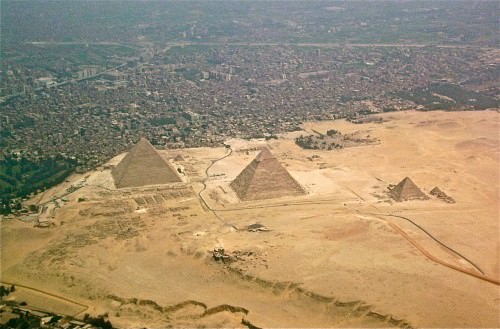
The Pyramids of Giza
La meseta de Giza presenta hoy una imagen muy diferente de lo que habría parecido en el tiempo del Reino Antiguo. No era el sitio solitario al borde del desierto, sino una necrópolis considerable que tenía tiendas, fábricas, mercados, templos, viviendas, jardines públicos y numerosos monumentos. La Gran Pirámide estaba envuelta en una cubierta exterior de reluciente piedra caliza blanca y se elevaba desde el centro de la pequeña ciudad, visible desde varios kilómetros a la redonda. Giza era una comunidad autosuficiente cuyo pueblo era un empleado del gobierno, pero la construcción de los enormes monumentos allí en la IV dinastía fue muy costosa. La pirámide y el complejo de Kefrén son un poco más pequeños que los de Kefuru y Menkaure más pequeños que los de Kefrén, y esto se debe a que, a medida que la construcción de la pirámide de la IV dinastía continuaba, los recursos disminuyeron. El sucesor de Menkaure,Shepsekhaf (2503 - 2498 aC) fue enterrado en una modesta mastaba en Saqqara.
The cost of the pyramids was not only financial but political. Giza was not the only necropolis in Egypt at the time and all of these sites required maintenance and administration which was carried out by priests. As these sites grew, so did the wealth and power of the priests and the regional governors (nomarchs) who presided over the different districts the sites were in. The later rulers of the Old Kingdom built temples (or pyramids on a much smaller scale) as these were more affordable. The shift from the pyramid monument to the temple signalled a deeper shift in sensibilities which had to do with the growing power of the priesthood: monuments were no longer being built to honor a certain king but for a specific god.
FIRST INTERMEDIATE PERIOD & MIDDLE KINGDOM
The power of the priests and nomarchs, along with other factors, brought about the collapse of the Old Kingdom. Egypt then entered the era known as the First Intermediate Period (2181 - 2040 BCE) in which individual regions essentially governed themselves. The kings still ruled from Memphis but they were ineffectual.
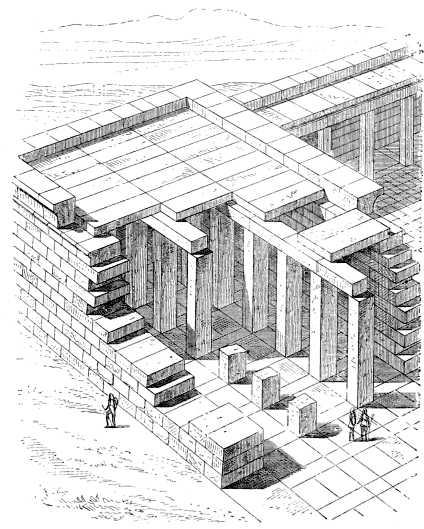
Egyptian Construction
Under the nomarchs, architecture survived the collapse of the Old Kingdom. Their patronage continued into the Middle Kingdom, resulting in such remarkable sites as Beni Hassan (c. 1900 BC) with its rock carved tombs and large chapels complete with columned porticos and painted walls (32).
When Mentuhotep II (c. 2061 - 2010 BCE) united Egypt under Theban rule, royal commissioning of art and architecture resumed but, unlike in the Old Kingdom, variety and personal expression was encouraged. Middle Kingdom architecture, beginning with Mentuhotep's grand mortuary complex at Deir el-Bahri near Thebes, is at once grand and personal in scope.
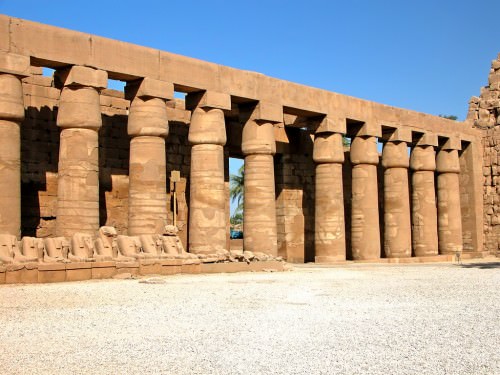
Temple of Amun, Karnak
Under the reign of king Senusret I (c. 1971 - 1926 BCE) the great Temple of Amun-Ra at Karnak was begun when this monarch erected a modest structure at the site. This temple, like all Middle Kingdom temples, was constructed with an outer courtyard, columned courts which led to halls and ritual chambers, and an inner sanctum which housed a god's statue. Sacred lakes were created at these sites and the entire effect was a symbolic representation of the beginning of the world and the harmonious operation of the universe. Bunson writes:
Temples were religious structures considered the "horizon" of a divine being, the point at which the god came into existence during creation. Thus, each temple had a link to the past, and the rituals conducted within its court were formulas handed down for generations. The temple was also a mirror of the universe and a representation of the Primeval Mound where creation began (258).
Columns were an important aspect of the symbolism of a temple complex. They were not designed only to support a roof but to contribute their own meaning to the whole work. Some of the many different designs were the papyrus bundle (a tighly carved column resembling papyrus reeds); the lotus design, popular in the Middle Kingdom, with a capital opening like a lotus flower; the bud column whose capital appears to be an unopened flower, and the Djed column which is probably most famous from the Heb Sed Court at Djoser's pyramid complex but was so widely used in Egyptian architecture it can be found from one end of the country to the other. The Djed was an ancient symbol for stability and frequently used in columns either at the base, at the capital (so it appears the Djed is holding up the sky), or as an entire column.

Palm-leaf Column of Ramesses II from Herakleopolis
Homes and other buildings continued to be made from mud brick during the Middle Kingdom; stone was only used for temples and monuments and this was usually limestone, sandstone or, in some cases, granite which required the greatest skill to work in. A little known masterpiece of the Middle Kingdom, long ago lost, was the pyramid complex of Amenemhat III (c. 1860 - 1815 BCE) at the city of Hawara.
This complex was enormous, featuring twelve great separate courts which faced one another across an expanse of columned halls and interior hallways so intricate that it was called "the labyrinth" by Herodotus. The courts and hallways were further connected by corridors and colonnades and shafts so that a visitor might walk down a familiar hall but take an unfamiliar turn and wind up in a completely different area of the complex than the one they had intended. Criss-crossing alleys and false doors sealed by stone plugs served to confuse and disorient a visitor to protect the central burial chamber of the pyramid of the king. This chamber is said to have been cut from a single block of granite and to have weighed 110 tons. Herodotus claimed it was more impressive than any of the wonders he had ever seen.
SECOND INTERMEDIATE PERIOD & THE NEW KINGDOM
Kings like Amenemhat III of the 12th Dynasty made great contributions to Egyptian art and architecture and their policies were continued by the 13th Dynasty. The 13th Dynasty, however, was weaker and ruled poorly so that, eventually, the power of the central government declined to the point where a foreign people, the Hyksos, rose in Lower Egypt while the Nubians took portions of land to the south. This era is known as the Second Intermediate Period (c. 1782 - 1570 BCE) in which there was little advancement in the arts.
The Hyksos were driven from Egypt by Ahmose I of Thebes (c. 1570 - 1544 BCE) who then secured the southern borders from the Nubians and initiated the era known as the New Kingdom (1570 - 1069 BCE). This period saw some of the most magnificent architectural feats since the Old Kingdom. In the same way that modern visitors are awed and intrigued by the mystery of how the pyramids at Giza were built, so are they by Hatshepsut 's funerary complex, the Temple of Amun at Karnak, the many works of Amenhotep III, and the magnificent constructs of Ramesses II such as Abu Simbel.
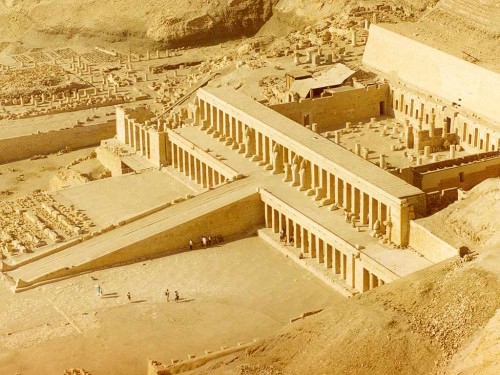
Temple of Hatshepsut
The rulers of the New Kingdom built on a grand scale in keeping with Egypt's new elevated status as an empire. Egypt had never known a foreign power like the Hyksos taking control of their land and, after Ahmose I drove them out, he initiated military campaigns to create buffer zones around Egypt's borders. These areas were expanded by his successors, most notably Thutmose III (1458 - 1425 BCE), until Egypt ruled an empire which stretched from Syria, down the Levant, across to Libya, and down through Nubia. Egypt became immensely wealthy during this time and that wealth was lavished on temples, mortuary complexes, and monuments.
El más grande de estos es el Templo de Amun-Ra en Karnak. Como con todos los otros templos en Egipto, este contó la historia del pasado, las vidas de las personas y honró a los dioses, pero fue un inmenso trabajo en progreso con cada gobernante del Nuevo Reino que se agregaba a él. El sitio cubre más de 200 acres y se compone de una serie de torres (puertas monumentales que se estrechan hacia la parte superior de las cornisas), que conducen a patios, salas y templos más pequeños. The first pylon opens onto a wide court which invites the visitor further. The second pylon opens onto the Hypostyle Court which measures 337 feet (103 meters) by 170 feet (52 meters). The hall is supported by 134 columns 72 feet (22 meters) tall and 11 feet (3.5 meters) around in diameter.Los eruditos estiman que uno podría acomodar tres estructuras del tamaño de la Catedral de Notre Dame dentro del templo principal solo. Bunson comenta:
Karnak remains the most remarkable religious complex ever built on earth. Sus 250 acres de templos y capillas, obeliscos, columnas y estatuas construidas durante más de 2,000 años incorporan los mejores aspectos del arte y la arquitectura egipcia en un gran monumento histórico de piedra (133).
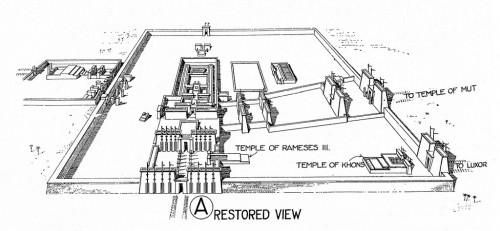
Temple of Amun Plan, Karnak
As with all other temples, Karnak is a paragon of symmetrical architecture which seems to rise organically from the earth toward the sky. The great difference between this structure and any other is its grand scale and the scope of the vision. Each ruler who contributed to the building made greater advances than their predecessors but acknowledged those who had gone before. When Thutmose III built his festival hall there he may have removed monuments and buildings of earlier kings whom he then acknowledged with an inscription. Every temple symbolizes Egyptian belief and culture but Karnak does so in large letters and, quite literally, through inscriptions. Thousands of years of history may be read on the walls and columns of the Karnak temple.
Hatshepsut (1479 - 1458 BCE) contributed to Karnak like every other ruler but also commissioned buildings of such beauty and splendor that later kings claimed them as their own. Among her grandest is her mortuary temple at Deir el-Bahri near Luxor which incorporates every aspect of New Kingdom temple architecture on a grand scale: a landing stage at the water's edge, flagstaffs (relics of the past), pylons, forecourts, hypostyle halls, and a sanctuary. The temple is constructed in three tiers reaching 97 feet (29.5 meters) and visitors are still amazed by the building in the present day.
Amenhotep III (1386 - 1353 BCE) built so many monuments throughout Egypt that early scholars credited him with an exceptionally long reign. Amenhotep III commissioned over 250 buildings, monuments, stele, and temples. His mortuary complex was guarded by the Colossi of Memnon, two figures 70 feet (21.3 m) high and each weighing 700 tons. His palace, now known as Malkata, covered 30,000 square meters (30 hectares) and was elaborately decorated and furnished throughout the throne rooms, apartments, kitchens, libraries, conference rooms, festival halls, and all the other rooms.
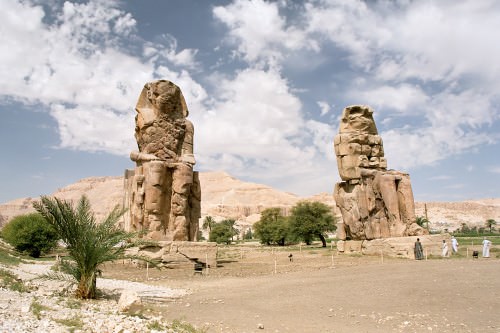
Colossi of Memnon
Although Amenhotep III is famous for his opulent reign and monumental building projects, the later pharaoh Ramesses II (1279 - 1213 BCE) is even more well known. Unfortunately this is largely because he is so often equated with the unnamed pharaoh in the biblical Book of Exodus and his name has become recognizable through film adaptations of the story and the incessant repetition of the line from Exodus 1:11 that Hebrew slaves built his cities of Pithom and Per-Ramesses.
Long before the author of Exodus ever came up with his story, however, Ramesses II was famous for his military exploits, efficient rule, and magnificent building projects. His city of Per-Ramesses ("City of Ramesses") in Lower Egypt was widely praised by Egyptian scribes and foreign visitors but his temple at Abu Simbel is his masterpiece. The temple, cut from solid rock cliffs, stands 98 feet (30 meters) high and 115 feet (35 meters) long with four seated colossi flanking the entrance, two to each side, depicting Ramesses II on his throne; each one 65 feet (20 meters) tall. Beneath these giant figures are smaller statues (still larger than life) depicting Ramesses' conquered enemies, the Nubians, Libyans, and Hittites. Further statues represent his family members and various protecting gods and symbols of power. Passing between the colossi, through the central entrance, the interior of the temple is decorated with engravings showing Ramesses and Nefertari paying homage to the gods.
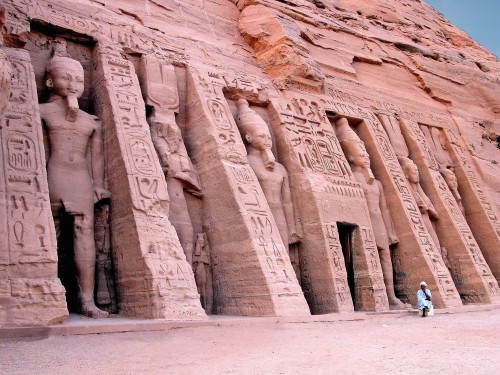
The Small Temple, Abu Simbel
Abu Simbel is perfectly aligned with the east so that, twice a year on 21 February and 21 October, the sun shines directly into the inner sanctum to illuminate statues of Ramesses II and the god Amun. This is another aspect of ancient Egyptian architecture which characterizes most, if not all, of the great temples and monuments: celestial alignment. From the pyramids at Giza to the Temple of Amun at Karnak, the Egyptians oriented their buildings according to the cardinal points and in keeping with celestial events. The Egyptian name for a pyramid was Mer, meaning "Place of Ascension" (the name "pyramid" comes from the Greek word pyramis meaning "wheat cake" which is what they thought the structures looked like) as it was believed that the shape of the structure itself would enable the dead king to rise toward the horizon and more easily begin the next phase of his existence in the afterlife. In this same way, temples were oriented to invite the god to the inner sanctum and also, of course, provide access for when they wanted to ascend back to their own higher realms.
LATE PERIOD & PTOLEMAIC DYNASTY
The New Kingdom declined as the priests of Amun at Thebes acquired greater power and wealth than the pharaoh while, at the same time, Egypt came to be ruled by weaker and weaker kings. By the time of the reign of Ramesses XI (c. 1107 - 1077 BCE) the central government at Per-Ramesses was completely ineffective and the high priests at Thebes held all the real power.
The Late Period of Egypt is characterized by invasions by the Assyrians and the Persians prior to the arrival of Alexander the Great in 331 BCE. Alexander is said to have designed the city of Alexandria himself and then left it to his subordinates to build while he continued on with his conquests. Alexandria became the jewel of Egypt for its magnificent architecture and grew into a great center of culture and learning. The historian Strabo (63 BCE - 21CE) praised it on one of his visits, writing :
The city has magnificent public precincts and royal palaces which cover a fourth or even a third of the entire area. For just as each of the kings would, from a love of splendour, add some ornament to the public monuments, so he would provide himself at his own expense with a residence in addition to those already standing (1).
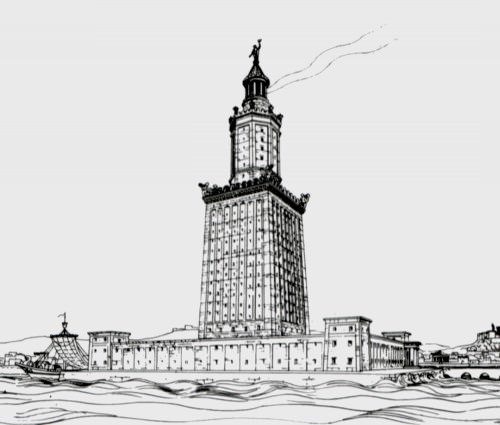
Lighthouse of Alexandria
Alexandria became the impressive city Strabo praises during the time of the Ptolemaic Dynasty (323 - 30 BCE). Ptolemy I(323 - 285 BCE) began the great Library of Alexandria and the temple known as the Serapeum which was completed by Ptolemy II (285 - 246 BCE) who also built the famous Pharos of Alexandria, the great lighthouse which was one of the Seven Wonders of the World.
The early rulers of the Ptolemaic Dynasty continued the traditions of Egyptian architecture, blending them with their own Greek practices, to create impressive buildings, monuments, and temples. The dynasty ended with the death of the last queen, Cleopatra VII (69 - 30 BCE), and the country was annexed by Rome. The legacy of the Egyptian architects lives on, however, through the monuments they left behind. The imposing pyramids, temples, and monuments of Egypt continue to inspire and intrigue visitors in the present day. Imhotep and those who followed after him envisioned monuments in stone which would defy the passage of time and keep their memory alive. The enduring popularity of these structures today rewards that early vision and accomplishes their goal.
LICENSE:
Article based on information obtained from these sources:with permission from the Website Ancient History Encyclopedia
Content is available under License Creative Commons: Attribution-NonCommercial-ShareAlike 3.0 Unported. CC-BY-NC-SA License